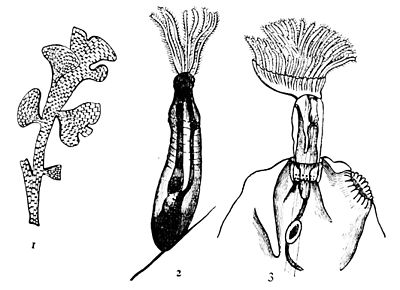croscope, a bit of a live bryozoan-patch would look like a bed of living daisies, for these flower-forms are in lively motion in every part. Sometimes these communities of moss-like animals, such as are known under the generic name Flustra, build their structures up like plants, and literally embower the oyster in the most exquisite of fairy groves. The cut Flustra foliacea, Fig. 3, represents a European species. Its fronds, so to speak, are flat, and spatula-formed. With its gracefully-spreading lobes, like fronds, it has often been mistaken for an alga, or sea-plant. If you will only look closely at this cut of Flustra foliacea, Fig. 3, it will be seen to be full of minute cells. A look at Fig. 4, 1, will make this plainer, while in Fig. 5, 1, by greatly magnifying, the form of these little chambers in one of the species is shown. The naturalist, speaking of the entire establishment of one of these communities, calls it Cœnœcium, which means the common house of all the individuals

Fig. 4.—1. Fragment of Flustra Truncata, Natural Size; 2. A single polypide of Valkeria magnified to show its crown of tentacles; 3. A polypide of Lophapus crystallinus, a fresh-water polyzoon highly magnified, showing its horseshoe-shaped crown of tentacles.
collectively; for each one of these little crypts, or chambers, is the exclusive apartment of one zooid, or individual member of the community. At the portal of this little crypt the occupant, when hungry, presents itself, and retires at its pleasure. When it does show itself, with tentacles spread, some idea of its individual beauty may be got by looking at the magnified tufts, like floral crowns, as shown in Figs. 4 and 5. When an entire community, or even a considerable part, is out airing, could one but see it, the sight would be very fine, for the smallest fragment in the microscope looks like a bed of daisies. The oyster is often literally embowered in a substance that looks like diminutive trees. Its color varies from a reddish to a very pale brown, almost gray. The oystermen call it "gray-beard." Shore--
